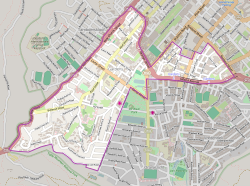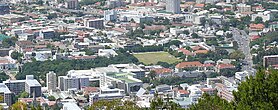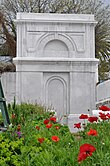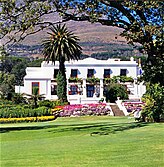This article needs additional citations for verification. (March 2007) |
Gardens (or The Gardens) is an affluent inner-city suburb of Cape Town located just to the south of the city centre located in the higher elevations of the "City Bowl" and directly beneath Table Mountain and Lion's Head. It is home to several national museums such as Iziko South African National Gallery and the Iziko South African Museum. The University of Cape Town also houses its Fine Arts department in the suburb, at Michaelis School of Fine Art. Company's Garden, South Africa's oldest garden, a public park and heritage site is a focal point of the suburb. The area is also home to the oldest synagogue in Southern Africa, the Old Shul (now occupied by the South African Jewish Museum) and its successor, the Gardens Shul, "The Mother Synagogue of South Africa."
Gardens | |
|---|---|
Clockwise from Top: View of The Gardens area, Leeuwenhof, Van Rheede Van Oudtshoorn Vault | |
 Street map of Gardens | |
| Coordinates: 33°56′0″S 18°24′30″E / 33.93333°S 18.40833°E | |
| Country | South Africa |
| Province | Western Cape |
| Municipality | City of Cape Town |
| Main Place | Cape Town |
| Government | |
| • Councillor | Vivienne Walker (DA) |
| Area | |
| • Total | 1.90 km2 (0.73 sq mi) |
| Population (2011)[1] | |
| • Total | 7,960 |
| • Density | 4,200/km2 (11,000/sq mi) |
| Racial makeup (2011) | |
| • Black African | 23.5% |
| • Coloured | 7.2% |
| • Indian/Asian | 2.0% |
| • White | 64.8% |
| • Other | 2.5% |
| First languages (2011) | |
| • English | 60.4% |
| • Afrikaans | 25.3% |
| • Xhosa | 3.6% |
| • Other | 10.8% |
| Time zone | UTC+2 (SAST) |
| Postal code (street) | 8001 |
It is also home to the storied Belmond Mount Nelson Hotel, a luxury hotel dating back to 1899,[2] as well as the Labia Theatre, a beloved independent art house cinema.[3] The main thoroughfare is Kloof Street, known for its fashion stores, second-hand furniture stores, restaurants and art galleries.[4] It also houses Leeuwenhof estate, the official residence of the Premier of the Western Cape. It is a hub for the Cape Town creative industry, home to e.tv at Longkloof Studios and many modelling agencies, production and publishing companies and associated industries.
History
editIn the early years, the Cape was used as an anchorage for Portuguese, Dutch and British ships. No permanent settlement existed until the Dutch East India Company issued a mandate to Jan van Riebeeck, a ship's surgeon, to establish a settlement which could provide passing ships with fruit, vegetables and fresh meat (traded from the locals).
In 1652 the first garden was laid out by Hendrik Boom, the Company's master gardener, on a site close to the Fresh River (near to the Grand Parade). Later that year, the garden crossed the Fresh River (where Adderley Street is today), and included a medicine garden. Within a few years it was 18 hectares in size.
As more produce became available from the Company's gardens at Newlands and from the Free Burghers who had settled along the Liesbeeck River, the town garden was slowly converted into a botanical and ornamental garden, although the growing of vegetables did continue for a number of years.
The famous kilometre-long Government Avenue, which runs from the top of Adderley Street, also known as 'The Gardens', was originally planted with lemon trees and in 1700 with orange trees. During the time of Simon van der Stel, it was lined with oak trees, which remain today.
The suburb is home to Southern Africa's oldest Jewish congregation. The first Jewish services in the country were held on the day preceding Yom Kippur in 1841, known as Erev Yom Kippur at Benjamin Norden's home, Helmsley Place. The Belmond Mount Nelson Hotel purchased Norden's former home in 1996 and it is now guest accommodation for the hotel.[5][6] In the early twentieth century, a Jewish primary school was established on Hope Street, United Hebrew Schools'. A purpose-built school was built at the same site in 1937, replacing the large house that had previously housed the school.[7] The school later became known as Herzlia School and relocated to its current campus in Vredehoek in the 1950s, where a high school was also established.[8]
During apartheid, Vredehoek was designated as a “whites-only” area as part of the Group Areas Act. The Gardens Centre Tower was built in the 1970s in response to a "white housing crisis" in racially segregated Cape Town. In the 1970s the National Party initiated several planning interventions, including the suspension of the city's zoning rules with regards to building height for developers willing to build housing in white Group Areas.[9] The residential tower and shopping mall replaced a large historic hotel, The International Hotel situated on Upper Mill Street. The South Africa national rugby union team (Springboks) usually stayed there when they were playing in Cape Town. The hotel also hosted bands and concerts over the weekends.[10]
Kloof Street mostly consisted of boarding houses for most of the twentieth century, many have now been converted into restaurants, cafes, boutiques and hotels.[11]
Places of interest
edit- Belmond Mount Nelson Hotel, one of the oldest and most historic hotels in all of Africa
- Leeuwenhof, the official residence of the Premier of the Western Cape
- Labia Theatre, one of the oldest independent movie theatres in the city
Parks
edit- Company's Garden, the oldest garden in South Africa, a public park and heritage site.
- De Waal Park is a public park and heritage site in the neighbouring suburb of Oranjezicht
Museums
edit- Iziko South African National Gallery, the national art gallery of South Africa
- Iziko South African Museum, the oldest in the country, was established in 1825 and houses important African zoology, palaeontology and archaeology collections. It also contains a planetarium.
- The South African Jewish Museum, opened in 2000, and housed in purpose-built modern buildings and in the original synagogue, known as 'The Gardens Shul', the oldest Jewish congregation in Southern Africa built in 1862. It is known as the “mother synagogue” of South Africa.[6] The twin-towered 'new' synagogue was built in 1905. Gardens, Vredehoek and Sea Point have traditionally attracted Jewish communities.[12]
- Cape Town Holocaust Centre, Africa's first Holocaust centre, founded in 1999
Houses of worship
edit- Gardens Shul, an Orthodox Jewish synagogue located in the historic Company Gardens
- St. Barnabas Church, Anglican church on Kloof Nek Road & Kamp Street
- Cape Peninsula Reformed Church, English-speaking congregation of the Dutch Reformed Church in South Africa (NGK) on Kloof Street
- Gereformeerde Kerk Kaapstad, Reformed church on Hof St
- The Union Chapel, Presbyterian church on corner of Kloof Street & Eaton Road
- Father's House Church, Assemblies of God church on Vrede Street
- Jubilee Community Church, located on Kloof Street
- New Life City Church Cape Town, Evangelical church on Kloof Street
Education
editSchools
editPublic
edit- Cape Town High School, an English medium co-educational high school
- Good Hope Seminary High School, an English medium all-girls high school founded in 1873 by Reverend Andrew Murray
- Gardens Commercial High School, an English-medium co-educational high school
- St Mary's Primary School, an English medium co-educational Catholic primary school
- Hoërskool Jan van Riebeeck, an Afrikaans medium high school[13]
- Jan Van Riebeeck Primary School, an Afrikaans medium primary school[14]
Private
edit- Lycée Français du Cap, the secondary division of the Cape Town French School, is located in Gardens.[15]
- St. Cyprian's School, an all-girls Anglican pre-primary, primary and high school in neighbourhing Oranjezicht[16]
Higher education
edit- Michaelis School of Fine Art, Fine Arts department of the University of Cape Town, founded in 1925 and named after its benefactor, Max Michaelis
- CityVarsity, a school of media and creative arts on Roeland St.
Libraries
edit- Kloof Street Public Library, at 122B Kloof Street
- Jacob Gitlin Library, a Jewish library and archive of information on Judaism, Jewish culture and history, and the nation of Israel
Transportation
editThe suburb is served by the MyCiTi bus rapid transit system. The 101 route takes passengers to Vredehoek and the Cape Town Civic Centre in central Cape Town. The 113 route takes passengers to Adderley Street and the V&A Waterfront. The 107 route goes to Camps Bay.[17]
In popular culture
edit- Age of Iron, a 1990 novel by J. M. Coetzee takes places in and around the suburb. The elderly white protagonist, Mrs. Curren lives in a home situated in the area of Breda Street, Schoonder Street and Vrede Street.[18]
- Mabu Viny, a record store, previously on 2 Rheede St, features prominently in the documentary, Searching for Sugar Man[19]
References
edit- ^ a b c d "Sub Place Gardens". Census 2011.
- ^ South Africans Cling to a Lovely Old City The New York Times. 20 January 1979
- ^ Curtains? Cape Town's much-loved art house cinema under threat The Guardian. 24 July 2014
- ^ The 33 coolest streets in the world TimeOut. 25 August 2022
- ^ Mount Nelson, A Belmond Hotel, Cape Town: A Timeline Belmond. Accessed on 12.9.23
- ^ a b Cape Town’s Jewish History on Display Forward. 29 April 2013
- ^ The history of Jewish education in South Africa, 1841-1980 (part 1) University of Cape Town. 1980
- ^ The history of Jewish education in South Africa, 1841-1980 (part 2) University of Cape Town. 1980
- ^ Building an icon: Disi Park Visi. 13 March 2023
- ^ Ugly as a wet mop, intriguing as a snake Vrye Weekblad. 8 March 2024
- ^ Lategan, Herman (2023). Son of a Whore: A memoir. Cape Town: Penguin Books. p. 7. ISBN 9781776391240.
- ^ The Future of Jewish South Africa Tablet Mag. 22 March 2023
- ^ "Hoërskool Jan van Riebeeck | Wees Uself". Janvanriebeeck.co.za. Retrieved 2022-04-11.
- ^ "Laerskool Jan van Riebeeck | Wees Uself". Jvrprim.co.za. Retrieved 2022-04-11.
- ^ "CONTACT." Cape Town French School. Retrieved on 22 January 2015. "Lycée Français du Cap 101, Hope Street - Gardens 8001 Cape Town South Africa" and "Ecole Française du Cap Corner Tramway and Kings road - Sea Point 8005 Cape Town South Africa"
- ^ "St Cyprian's | Girls School | Cape Town". Stcyprians.co.za. Retrieved 2022-04-11.
- ^ MyCiTi System Map Accessed on 12.9.2023
- ^ Spiritual and material dimensions of home in J. M.Coetzee’s Age of Iron Jagiellonian University. 2022
- ^ The world’s best record shops #020: Mabu Vinyl, Cape Town The Vinyl Factory. 19 May 2016




